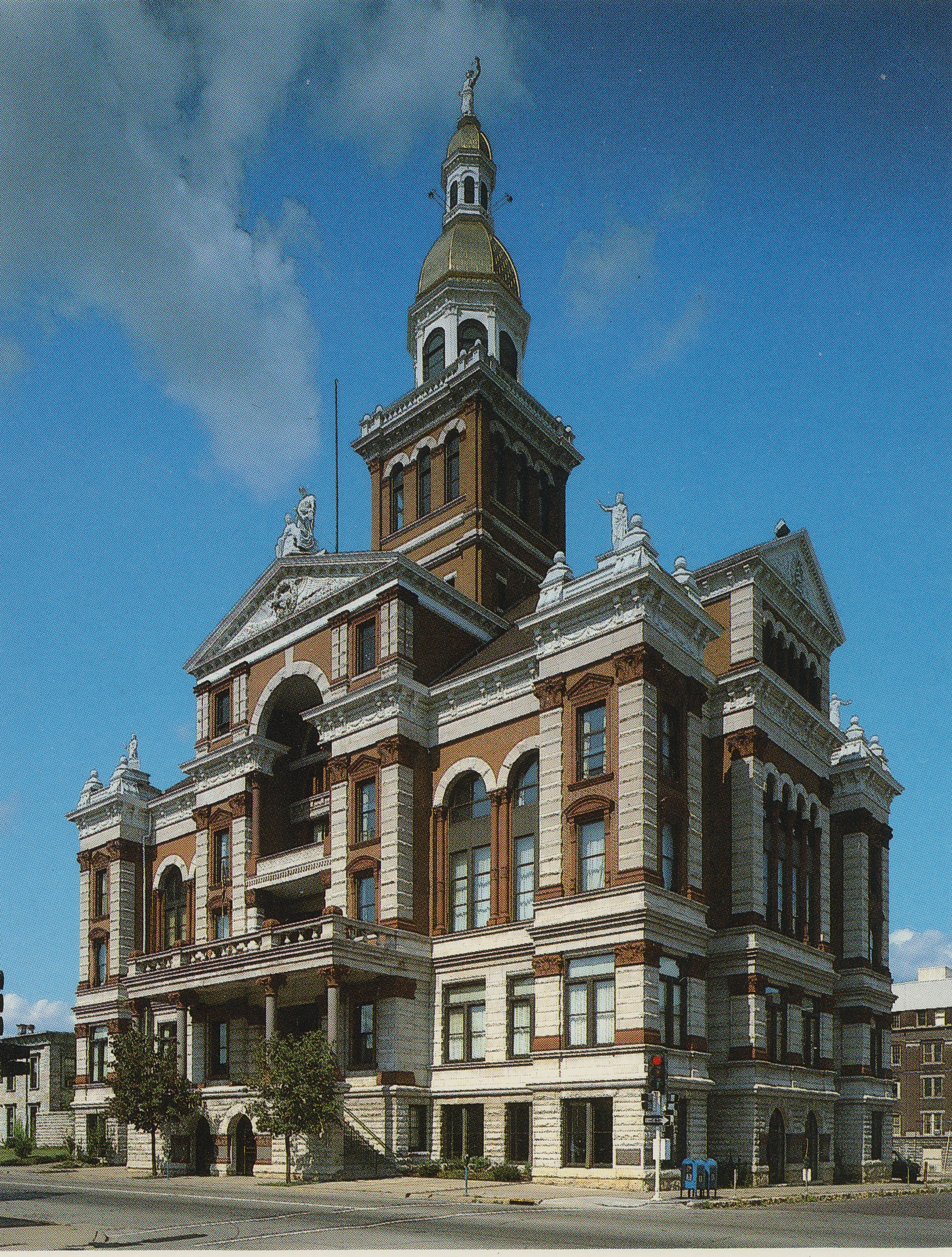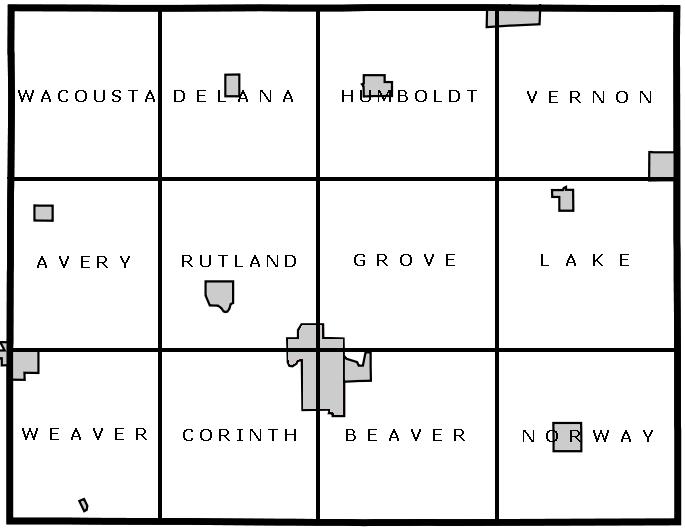|
St. Joseph, Iowa
St. Joseph is an unincorporated community and census-designated place (CDP) in Riverdale Township, Kossuth County, Iowa, United States. As of the 2010 census the population was 61. Geography The community is located in southern Kossuth County, in the southeast part of Riverdale Township, south of Algona along US 169 very close to the Humboldt County line. It is north of Humboldt via US 169. Iowa Highway 408 leads east from St. Joseph to Lu Verne. According to the U.S. Census Bureau, the St. Joseph CDP has an area of , all land. It is bordered to the east by the East Fork of the Des Moines River. History One of the earliest histories states "the town was never laid out, as far as the records show, but grew by evolution." The settlement of St. Joseph was formerly known as "Hale". St. Joe began its official existence in 1865 when Oscar Hale, the first landowner of the area, started a post office and hotel. The new community then became known as Hale's post office or Hale. ... [...More Info...] [...Related Items...] OR: [Wikipedia] [Google] [Baidu] |
Census-designated Place
A census-designated place (CDP) is a concentration of population defined by the United States Census Bureau for statistical purposes only. CDPs have been used in each decennial census since 1980 as the counterparts of incorporated places, such as self-governing cities, towns, and villages, for the purposes of gathering and correlating statistical data. CDPs are populated areas that generally include one officially designated but currently unincorporated community, for which the CDP is named, plus surrounding inhabited countryside of varying dimensions and, occasionally, other, smaller unincorporated communities as well. CDPs include small rural communities, edge cities, colonias located along the Mexico–United States border, and unincorporated resort and retirement communities and their environs. The boundaries of any CDP may change from decade to decade, and the Census Bureau may de-establish a CDP after a period of study, then re-establish it some decades later. Most unin ... [...More Info...] [...Related Items...] OR: [Wikipedia] [Google] [Baidu] |
2010 United States Census
The United States census of 2010 was the twenty-third United States national census. National Census Day, the reference day used for the census, was April 1, 2010. The census was taken via mail-in citizen self-reporting, with enumerators serving to spot-check randomly selected neighborhoods and communities. As part of a drive to increase the count's accuracy, 635,000 temporary enumerators were hired. The population of the United States was counted as 308,745,538, a 9.7% increase from the 2000 census. This was the first census in which all states recorded a population of over half a million people as well as the first in which all 100 largest cities recorded populations of over 200,000. Introduction As required by the United States Constitution, the U.S. census has been conducted every 10 years since 1790. The 2000 U.S. census was the previous census completed. Participation in the U.S. census is required by law of persons living in the United States in Title 13 of the United ... [...More Info...] [...Related Items...] OR: [Wikipedia] [Google] [Baidu] |
Cattle Baron
Cattle baron is a historic term for a local businessman and landowner who possessed great power or influence through the operation of a large ranch with many beef cattle. Cattle barons in the late 19th century United States were also sometimes referred to as cowmen, stockmen, or just ranchers. In Australia, similar individuals owned large cattle stations. A similar phenomenon occurred in part of Canada in the early twentieth century. Notable examples ''In the American Old West:'' * Otto Franc *Charles Goodnight. Essayist and historian J. Frank Dobie said that Goodnight "approached greatness more nearly than any other cowman of history." *John Chisum *Tom McCall *Conrad Kohrs; see Grant-Kohrs Ranch National Historic Site *Oliver Loving * James Dolan *Susan McSween *Frank Wolcott *Margaret Borland ''In Australia:'' * Peter Menegazzo *Sidney Kidman ''In Canada:'' *The Big Four (Calgary) (four businessmen: two ranchers, a meat packer, and a brewer who founded the Calgary Stamp ... [...More Info...] [...Related Items...] OR: [Wikipedia] [Google] [Baidu] |
Dubuque, Iowa
Dubuque (, ) is the county seat of Dubuque County, Iowa, United States, located along the Mississippi River. At the time of the 2020 United States Census, 2020 census, the population of Dubuque was 59,667. The city lies at the junction of Iowa, Illinois, and Wisconsin, a region locally known as the Dubuque area, Tri-State Area. It serves as the main commercial, industrial, educational, and cultural center for the area. Geographically, it is part of the Driftless Area, a portion of North America that escaped all three phases of the Wisconsin Glaciation. Dubuque is a tourist destination featuring the city's unique architecture and river location. It is home to five institutions of higher education, making it a center for culture and learning. Dubuque has long been a center of manufacturing, the local economy has also diversified to other areas in the 21st century. Alongside previously mentioned industries, the city has large health care, publishing, and financial service sectors. Hi ... [...More Info...] [...Related Items...] OR: [Wikipedia] [Google] [Baidu] |
Wisconsin
Wisconsin () is a state in the upper Midwestern United States. Wisconsin is the 25th-largest state by total area and the 20th-most populous. It is bordered by Minnesota to the west, Iowa to the southwest, Illinois to the south, Lake Michigan to the east, Michigan to the northeast, and Lake Superior to the north. The bulk of Wisconsin's population live in areas situated along the shores of Lake Michigan. The largest city, Milwaukee, anchors its largest metropolitan area, followed by Green Bay and Kenosha, the third- and fourth-most-populated Wisconsin cities respectively. The state capital, Madison, is currently the second-most-populated and fastest-growing city in the state. Wisconsin is divided into 72 counties and as of the 2020 census had a population of nearly 5.9 million. Wisconsin's geography is diverse, having been greatly impacted by glaciers during the Ice Age with the exception of the Driftless Area. The Northern Highland and Western Upland along wi ... [...More Info...] [...Related Items...] OR: [Wikipedia] [Google] [Baidu] |
Des Moines River
The Des Moines River () is a tributary of the Mississippi River in the upper Midwestern United States that is approximately long from its farther headwaters.U.S. Geological Survey. National Hydrography Dataset high-resolution flowline dataThe National Map , accessed May 26, 2011 The largest river flowing across the state of Iowa, it rises in southern Minnesota and flows across Iowa from northwest to southeast, passing from the glaciated plains into the unglaciated hills near the capital city of Des Moines, named after the river, in the center of the state. The river continues to flow at a southeastern direction away from Des Moines, later flowing directly into the Mississippi River. The Des Moines River forms a short portion of Iowa's border with Missouri in Lee County. The Avenue of the Saints, a four-lane highway from St. Paul, Minnesota to St. Louis, Missouri, passes over this section; the highway is designated Route 27 in both Iowa and Missouri, and was completed in the ear ... [...More Info...] [...Related Items...] OR: [Wikipedia] [Google] [Baidu] |
Lu Verne, Iowa
Lu Verne is a city in Humboldt and Kossuth counties in the U.S. state of Iowa. The population was 258 at the time of the 2020 census. History Lu Verne was platted in 1880. It was named after Luverne, Minnesota. Lu Verne was formerly serviced by Iowa Highway 408, which was decommissioned in 1980. Geography Lu Verne is located at (42.911638, -94.083618). According to the United States Census Bureau, the city has a total area of , all land. Demographics 2010 census As of the census of 2010, there were 261 people, 117 households, and 72 families living in the city. The population density was . There were 152 housing units at an average density of . The racial makeup of the city was 96.9% White, 1.5% Native American, 0.4% from other races, and 1.1% from two or more races. Hispanic or Latino of any race were 3.8% of the population. There were 117 households, of which 28.2% had children under the age of 18 living with them, 42.7% were married couples living together, 11.1% had ... [...More Info...] [...Related Items...] OR: [Wikipedia] [Google] [Baidu] |
Iowa Highway 408
Beginning in 1979 and lasting through the early 1980s, a series of agreements between the Iowa Department of Transportation and individual county boards of supervisors led to a mass transfer of jurisdiction of several state highways in Iowa. County boards of supervisors were asked to convene functional classification boards in order to review the classification all of the highway miles within each respective county. Control of roads that were classified as trunk roads or trunk collector roads were transferred to the counties, while roads classified as arteries or arterial collectors were transferred to the state department of transportation. The vast majority of transfers took place in 1980. Background The 67th Iowa General Assembly passed a bill in 1978 that changed how the state department of transportation (DOT) classified highways and how they were funded throughout the state. The bill enacted an existing framework for county boards of supervisors to create reclassifica ... [...More Info...] [...Related Items...] OR: [Wikipedia] [Google] [Baidu] |
Humboldt, Iowa
Humboldt is a city in Humboldt County, Iowa, United States. The population was 4,792 at the time of the 2020 census, gaining 340 people over the 2000 total. History Frank A. Gotch Park (just south of present-day Humboldt and Dakota City) was a location of prehistoric and some Dakota Indian villages near where the two forks of the Des Moines River meet. During westward expansion in the 1800s, this area is thought to be the location of a fort/trading post called Fort Confederation. According to Federal records in 1825, permission was granted to build the fort to trade with the Ihanktonwan Dakota (Yankton Sioux) Indians. Information about the exact details of the fort are unclear, such as if American or French Canadian or Metis traders built it, bringing up many questions about this fort. The founder of modern Humboldt, Stephen Harris Taft, laid out the plans for Springvale, the original name of the town, in 1863. It was named Springvale because of the several natural springs fo ... [...More Info...] [...Related Items...] OR: [Wikipedia] [Google] [Baidu] |
Humboldt County, Iowa
Humboldt County is a county in the U.S. state of Iowa. As of the 2020 census, the population was 9,597. The county seat is Dakota City. The county was created in 1857 and named in honor of Alexander von Humboldt. History Founding Iowa's entry to the union was approved by Congress on March 3, 1845, with statehood beginning on December 28, 1846, following approval of the state's constitution and boundaries. In order to establish county government across the state, the Iowa General Assembly passed an act on January 15, 1851, which created fifty counties in the half of the state where county government had not yet been established. Humboldt County was created by this act, containing its present area, as well as four townships in present-day Webster County: Jackson, Deer Creek, Badger, and Newark. It was named after Alexander von Humboldt. On January 21, 1855, an act merged the northern half of Humboldt County and Bancroft County into Kossuth County, with the southern half of Humb ... [...More Info...] [...Related Items...] OR: [Wikipedia] [Google] [Baidu] |



